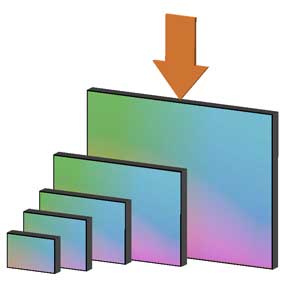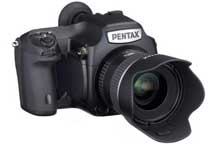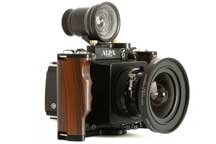Micro 4/3 Sensor
Mirrorless Cameras
Smallest size sensor pro-photagraphers
will use for a paid shoot. Acceptable image quality, but poor in low light.
Photographer will say this is "good enough" for certain gigs,
especially for web pages. Note: Olympus and Panasonic M4/3 lens are interchangeable.
By now, there is a huge selection of lens.
Crop factor: 2
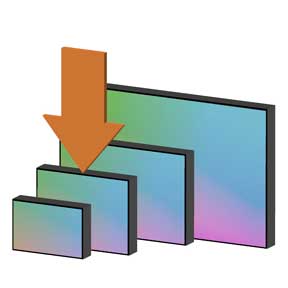
|
Olympus OM-D E-M5 (Obsolete):
16MP $999 Introduced 2012 Why does it exist: First mirrorless camera to
have fast focus. Why not: Cannot track focus: source
. First generation view finder is slow and color is off.
History: Until 2010, Olympus had 4/3 sensor DSLR camera. These lens are
called 4/3 lens. (Not micro 4/3, so don't get confused.) However, their
4/3 camera could not compete with Nikon and Canon, so they switched to
mirrorless 4/3 called micro 4/3. Mirrorless to try to emphasize on the
smaller size.
Special features: 5 axis stabilization, but there has been complaint of
a humming noise at all times from stabilization system. Weather seal and
partial magnesium case. Top and the important front are magnesium. Two
control dials. Flash sync 1/250 sec. Articulating LCD. No build in flash.
Electronic viewfinder is lower resolution 1.44M-dots. First generation
viewfinder has very
different color balance than LCD. Recent price drop to $599.
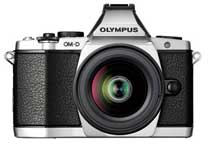
|
Olympus E-PM2 (Obsolete): 16MP $400
Introduced 2012 Why does it exist: Same sensor, processor as E-M5, but
in a super compact body. Why not: No viewfinder is why is so small. No
build in flash, but has compact external flash. Image stabilization. Fast
focus, but like the E-M5, cannot track an object. Very capable camera
that can be had for cheap now.
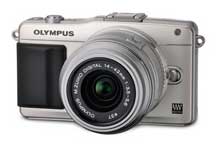
|
| OM-D E-M1: $1,299 16.3MP Introduced
in 2013 Why does it exist: Top of the OM-D line. Focus point on sensor
and almost waterproof. Why not: Look at GX7 that is just as capable, but
maybe less waterproof.
Better auto focus with legacy DSLR 4/3 lens because of focus points on
sensor. Pretty well focus
tracking most of the time in good lighting. Focus peaking to assist
focus with manual lens. High resolution 2.3M-dot electronic viewfinder.
No anti alias filter for sharp image. Highly acclaimed 2 position toggle
on back of camera to switch functions assigned to dials. Great weather
seal and all magnesium construction. One reviewer even did a shower
test with the camera and survived. Build in WiFi. This camera comes
pretty close to DSLR in auto focus tracking.

|
Panasonic DMC-GX7: 16MP $697 Introduced
in 2013 Why: Compact camera with professional features and controls. GX7
has fast .1 sec. autofocus, but still cannot focus on kids running towards
the camera. Original GX1 is and slow. GH3 is suppose to be good for AF
tracking, but is still not good for objects moving towards the camera.
This one still cannot really focus track. GX7 does have a unique pop-up
flash that can be adjusted to bounce off ceiling for softer light. Notable
features includes: high resolution 2.3M-dot electronic viewfinder that
has accurate color (Unlike OM-D E-M5's viewfinder that has off color),
and is .70X equiv. magnification. That is higher than Nikon D7100 DSLR
that has .63X, and close to the champion Canon 1D X that has .76x magnification.
So you see a large picture in the viewfinder. In body sensor stabilization.
1/320 flash sync that is faster than most cameras including Panasonic's
GH4, which has 1/250. Flash can control wireless external flashes. 3 level
focus peaking. Magnesium body. Front and rear control dials, 4 physical
customizable buttons with 3 different configuration setting modes. This
type of control is in the pro-camera category. Good viewfinder, dual dial
and 1/320 flash sync makes this a full featured camera that is a notch
better than many other cameras. Loved by many M4/3 photographers. Price
dropped from $1,097 to $697 makes this a very attractive option.
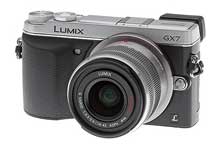
|
Olympus OM-D E-M10: $699 16.3MP
Introduced in 2014 Why does it exist: Lower grade OM-D camera. Why not:
Low resolution viewfinder.
No weather seal. 3 axis stabilization instead of 5. Does have the popular
two "2x2" dials with toggle function switch that is very versatile.
Focus peaking display for manual lens.
Cost from lowest to highest: E-M10 < E-M5 < E-M1 (hightest grade).
They all have 16.4MP sensor resolution, however, performance of sensor
for ISO and dynamic range increase as you go up in cost. Therefore, image
quality goes up with the other more expensive cameras. Same lower resolution
1.44M-dot viewfinder as E-M5 instead of high resolution 2.3M-dot of E-M1.
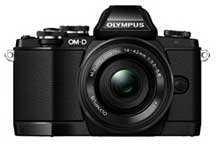
|
Olympus PEN E-P5: Introduced in
2013 $999 16.3MP Why: Competition to GX7 above. Basically a E-M5 without
the SLR look and viewfinder. Why not: Not that competitive with GX7 IMHO.
No build in view finder. Same sensor as OM-D E-M5, but with weaker anti-aliasing
filter for sharper image. Has 5 axis stabilization, but not
as effective as 5-axis on E-M5. Note that this E-P5 is different than
E-PL5. The E-PL5 belongs in the PL (PEN Lite) line that is consumer oriented
with less controls. This P5 has front and back dials like pro-oriented cameras.
Lightning fast autofocus.
Optional excellent 2.3M-dot $279 VF-4 view finder. Viewfinder is 1.48X magnification.
That is equivalent to .74X on full frame. Only Canon 1DX is larger at .76X!
Can also use slightly lower cost $249 VF-2 with .72X equiv. magnification.
VF-2 has lower 1.44M-dot resolution viewfinder that is equivalent to E-M5
view finder. New focus peaking, but there is a refresh delay on that feature
that is bothersome. Build-in WiFi and "2x2" two dials with toggle
to change dial function like the pro Olympus cameras. Tiltable LCD screen.
Camera has a pop up flash. Note: Optional flash use same slot as optional
viewfinder. Put one or the other on, but not both. Lacks weather seal of
E-M5.
Bottom line: $999+$279 for VF-4 viewfinder = $1,278. E-M5 is $999. You get
better viewfinder than E-M5, but here you cannot use external flash at the
same time, and no weather seal. Not as effective 5-axis stabilization. Compare
with E-M10 at $699, the E-M10 is cheaper, but with 3 instead of 5 axis stabilization,
and lesser viewfinder. Tough choice.
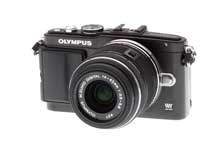 |
Olympus PEN E-PL7: Introduced in 2014 $699 16MP Why:
Economic camera. Not prosumer like E-P5 that has dual dials, but better
than consumer E-PL6 with no control dial. 3 axis stabilization, tilt LCD
screen with 180deg tilt. Single control dial. WiFi. This has the picture
quality of the OM-D SLR camera, but in a more consumer oriented point
and shoot type body. Lightning fast autofocus.
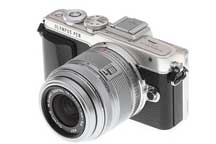
|
Panasonic GH4 Introduced in 2014
$1,697 Why does it exist: One of few cameras with cinema quality 4k movie
and very fast autofocus. Why not: Sensor too small for low light scene,
so cannot be for all around serious movies. Designed specifically for
movies with camera on the side. Unlike the GX7 that is made for picture,
and has video on the side. Fast focus mirrorless M4/3 camera. Have new
DFD, Depth from Defocus to predict where to focus for super incredibly
fast focus. Can be as fast as Sony A6000. Single point focus is faster
than most DSLR. Focus tracking is still a question. 2.36M-pix viewfinder
.67X equivalent magnification. That is even more magnification than Canon
7D that has .66X equiv. magnification. Canon 7D is considered industry
leading in magnification for this range of camera. This viewfinder is
suppose to have very
minimal lag, and 10,000:1
contrast ratio.
Reason this is potentially better for movies than DSLR like Canon 70D
and 5D for several reasons: Can use viewfinder in movie mode. Way better
focus performance in video mode than DSLR. Has focus peaking for manual
focus, and zebra for exposure. Canon only has that in the Cinema line
that is >$5k-$25k. However, not a low light performer because of the
small M4/3 sensor. Better than Blackmagic movie cameras. Can use optional
(very expensive) $2,000 DMW-YAGH module that expands connection to XLR
mic and 4 SDI output. If you are a pro, and got to have it, it will make
this into a pro cinema camera more or less.
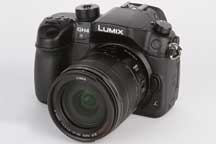
|
Panasonic DMC-GM5 Introduced in 2014
16MP Why: Aim to be smallest size interchangable lens camera. Why not: Sacrafice
on: no tilt LCD, no internal flash, no image stabilization. Comes with thin
12-32mm f3.5-5.6 lens. But does have a small .59X electronic view finder.
Has same sensor as GX7. Has hotshoe for external flash. Has improved autofocus
compared with older version GM1.
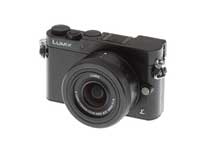 |
| Panasonic DMC-GX8: 20MP $XXX Why: Highest
MP yet for a M4/3 camera. Rangefinder style body. |
APS-C Sized Sensor
Mirrorless Cameras
Smaller APS-C sized sensor for those who don't
want to pay the price for full frame sensor. Mirrorless for thinner camera,
but about the same weight really.
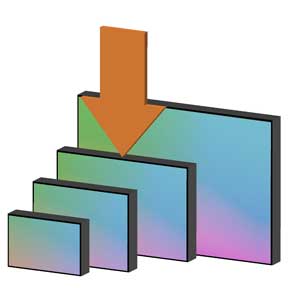
|
| Sony NEX 7 (Obsolete) Came
out in 2011 Why doe it exist: It does not exist anymore, is obsolete now.
This is a prosumer level APS-C mirrorless camera for Sony. Is the first
serious departure from the translucent mirror that Sony previously used
on A77 above. Is a first indication that mirrorless will trumpt translucent
mirror. Obsolete most likely because it has slow focus. source
|
Sony NEX 6 (Mostly obsolete -
Get a6000) Came out in 2012 $449 - Sony is not involved with
Micro 4/3 sensor mirrorless camera, but they are into APS-C sized mirrorless
camera. NEX 6 is a mid range camera. The main difference between NEX6
and the lower NEX models is this one has an electronic viewfinder. This
is the baselevel for a serious prosumer camera. Have phase detect sensors
that is suppose to make focus as fast as DSLR, but the camera is still
not as fast. NEX camera can only use Sony NEX lens, and not Sony Alpha
lens. NEX camera can also use Zeiss Touit series of prime lens. Touit
lens are made for both Sony and Fujifilm with different mounts. Large
.73X equiv. magnification viewfinder.
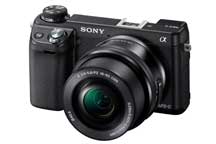
|
Fujifilm X-Pro1 (Superceeded
by X-E2) Came out in 2012 $899 16.3MP Why does it exist: Range finder camera.
Claim to fame is hybrid optical viewfinder with electronic viewfinder overlay.
Why not: Slow autofocus. Viewfinder is fixed for a equivalent 18mm lens.
If you attach a longer zoom lens on the camera, a smaller box in the viewfinder
indicate where the framing of the picture is. Somewhat ad hoc. Advantage
of optics viewfinder with added information from electronic overlay. Aluminum
construction, no X-trans sensor. This camera has been overcome by technology.
When it came out, electronic viewfinders had lots of lag, and poor quality.
Most of those issues are fixed. But this still have the quality construction
of older camera.
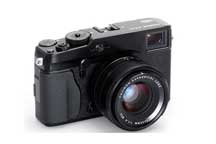 |
Canon EOS M2 Came out in
2013 $799 drop to $400 18MP Why: Canon join mirrorless bandwagon. Why not:
Painfully slow and unreliable autofocus. Did not sell at all. APS-C sensor.
Started in 2012 with EOS M. Year latter came out with M2. Still slow focus.
Great picture and sharp lens, but painfully slow autofocus that is not reliable
all the time. Use EF-S line of lens, optional adaptor to use all the other
Canon EF lens. Currently is discontinued.
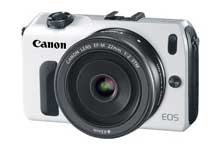 |
Fujifilm X-A1,Fujifilm X-M1,Fujifilm
X-E2 16.3MP Came out in 2013 $499,$599,$1,199 respectively w/ 16-50mm
f3.5-5.6 kit lens. Why does it exist: Compact range finder style mirrorless
camera with electronic viewfinder. Why not: Slightly slow autofocus. These
are all lower grades than the top of the line Fuji X-T1. X-T1 is shaped
like a legacy SLR film camera to show that is in a different class.
X-A1 has very low resolution .92M-dot viewfinder, no X-Trans sensor. Slow
1/180 flash sync. Pop-up flash. Still relatively low resolution1.04M-dot
viewfinder.
X-M1 has in addition to X-A1: X-Trans sensor that does not require Anti-Ailias
filter by randomizing color sensors. Lack of filter results in sharper image.
Focus peaking for manual lens.
X-E2 has in addition to X-M1: On chip auto focus detector, Build in WiFi.
High resolution 2.36M-dot viewfinder .64X equivalent magnification. (Magnification
on the low side) Top and front plates are magnesium, rest are plastic. No
weatherseal.
Beware when comparing image on dpreview or other sites that Fuji state their
ISO higher than actual. Their high ISO noise is no better than the competition.
Same thing that Olympus does. I see not significant advantage to Fujifilm
camera relative to other players.

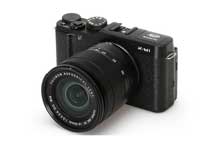 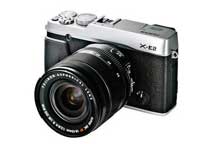 |
Sony a6000 $798 Introduced
in 2014 Why does it exist: This along with Panasonic GH4 both release
in 2014 are suppose to be a game changer for mirrorless. Suppose to match
DSLR in auto focus ability. 24.3MP Contrast and phase detect. Should have
excellent focus speed. Why not: Autofocus still cannot track, and user
report issues with focus hunting. Priced between NEX5 and NEX6. Currently
is the fastest autofocus mirrorless camera. Makes NEX6 somewhat obsolete.
NEX5 at this point has too slow autofocus. Still cannot completely do
focus tracking like DSLR can. a6000 use Sony NEX or Zeiss Touit mirrorless
lens. Sony native NEX lens in general do not have very good review unlike
the Sony Alpha lens for its translucent camera like the A77ii. Get Zeiss
Touit prime lens for good quality. You are still left without a good zoom
lens for this camera. 344g weight.
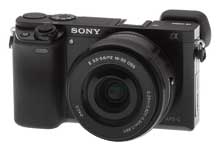
|
Fuji X-T1: $1,300 Introduced
in 2014 Why does it exist: Looks like a traditional Fujifilm SLR camera.
This is currently the highest level APS-C mirrorless camera for Fuji.
Came out in 2014. Why not: Fuji-autofocus speed can be an issue. Firmware
upgrade should help, but still cannot focus track. Fuji XT1 with 35mm
F1.4 is very slow. On the positive side, Fujifilm is going to release
a very wide 16-50mm f2.8 zoom lens. Canon and Nikon do not have fast zoom
lens that goes down to 16mm. 17mm on a Canon and Nikon is just not wide
enough. 50-140mm f2.8 is also coming to add to their line up for a capable
system. This will be a small and thin APS-C mirrorless camera with some
capable lens. Only auto focus is the question. X-T1 is very similar in
performance to X-E2. They use the same sensor. Fuji cameras in general
does not have very fast autofocus.
Beware when comparing image on dpreview or other sites that Fuji state
their ISO higher than actual. Their high ISO noise is no better than the
competition. Same thing that Olympus does.
X-T1 is similar to X-E2 with addition of: Magnesimu case weather sealed.
8FPS instead of 7FPS speed. Larger .77X instead of .64X viewfinder of
the X-E2. Articulating LCD. 440g instead of 350g. No pop-up flash on X-T1,
but include EF-X8 external flash. X-E2 has one.
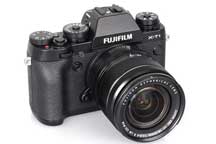
|
Sony SLT-A77: (Obsolete, replaced
by A77 II) $1,098 Came out in 2011 Why does it exist: Sony tries
to compete with Nikon and Canon, but does it without a mirror. Before
mirrorless focus technology was in place, Sony tried to use a translucent
mirror instead of a hard mirror for their DSLR. The translucent mirror
blocked about half a stop of light, or 33% loss, entering the sensor per
dpreview. Half a stop, or 33% loss of light sounds like a lot, but consider
that the human eye has about 6.5 stops, and with change in the irus, 20
stops, half a stop is not that noticeable. Sony and reviews claims that
half a stop of light does not matter, but the system did not catch on.
Reality is, you will have to use higher ISO number, and that cause more
picture noise. These Alpha camers has to use Sony Alpha lens. Sony therefore
carries both Alpha and newer mirrorless NEX lens.
Sony SLT-A77 II: $1,098 Introduced in 2014 Why does
it exist: Translucent mirror for very fast autofocus during liveview or
movies. Why not: Translucent mirror in the path of light takes away 1/3
to 1/2 EV of light, and some resolution also. Not a huge problem, but
there is the principle that you don't put a thick glass in the optical
path. It will take away some light and resolution. This camera introduction
shows Sony is still serious about its translucent mirror technology, and
not abandoning it for mirrorless camera. 24MP. Sony in the past has been
accused of abandoning their camera lines and changing to new technologies.
Sony wants to be a serious player, so they are sticking to translucent
mirror. Note that Nikon that has legacy lens that are compatible going
back to the 70's. Canon compatibility goes back to the 80's. Translucent
technology is almost obsolete. To make this camera competitive, Sony bundle
with 16-50mm f2.8 lens for $1,298. Good price for a lens that goes as
wide as 16mm. Sigma and Tamron only goes down to 17mm. That 1mm does make
a difference.
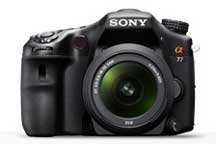
|
Samsung NX3000 Introduced
in 2014 $499 w/16-50mm f3.5-5.6 lens. 20MP Why does it exist: Not that interesting
of a camera. Mirrorless, thin and light, APS-C, but no viewfinder. Similar
to lower end Sony mirrorless NEX-3 and NEX-5. Could be good second camera.
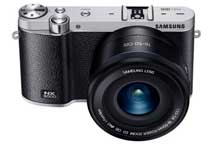 |
Samsung NX30 $799 20MP
Introduced in 2014 Why does it exist: Nothing special here. Samsung before
NX1 below has not been very competitive with their camera line. This one
has large size for comfort, and light weight for carrying. 375g and very
comfortable grip.A light DSLR has a little appeal. Android interface with
WiFi, so camera apps are available, and easy connection to phone.This may
be the perfect combination for ergonomics. Hybrid AF system. Articulating
viewfinder. Very fast autofocus in good to moderate light. Slows down in
poor light. Display lag in low light is bothersome. Use Samsung NX lens.
The Line of lens is growing. They have an impressive fast 16-50mm f2.0-2.8
lens. f2 is pretty impressive fast, and 16mm is just what is needed for
wide angle. Nikon, Canon, Sigma and Tamron only start at 17mm or 18mm, and
that is not low enough.
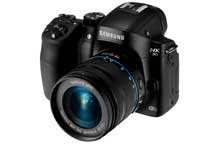 |
Samsung NX1 $1,499 28.2MP
Introduced in 9/2014 Why: Three letters: "BSI". Stole the show
at 2014 Photokina. Significant leap in camera technology with BSI, Back
Side Illumination sensor. Light sensors are in front, and wires and circuits
are behind the light sensor so circuit wires do not block the light. This
is suppose to be the one to beat Nikon and Canon and steal the crown from
the legacy manufacture. But alas, performance was not as good as expected.
DxOMark
show some improvement in noise, but significant decrease in dynamic range.
It turns out that BSI is greate for cell phone with tiny sensors, but
larger sensors have significantly more sensing area aleady, so some blocking
by wires is insignificant. However, it does have the highest MP sensor
for APS-C cameras. 28MP vs 24MP for its competition. Sensor has extensive
auto focus cells for fast focus. Focus is fast, but still cannot track
like DSLR. At this point, people wonder if mirrorless will ever be able
to focus track an object like DSLR. First camera to use Codec H.265 instead
of H.264 for video compression. Much more sophisticated, and compress
twice as much video data. 4K video. Fastest .5 millisecond delay for electronic
viewfinder. DRIMe V processor is hardwired to process signal directly
instead of running thru software codes to do the processing. Should be
very fast. The hardwired program can also be changed in the future. Processor
so powerful, there is a function to detect 100mph baseball just as it
contact the bat to take a shot. More sports program are on the way. Sensor
is capable of puting out 240FPS
at full 28MP. That is unimaginably fast shotting speed. However, current
software limits camera to 15FPS. 1/8000 shutter speed with 1/250 flash
sync. Theoretically, this camera should be able to do electronic shutter
with 1/250 scan rage. That would eliminate rolling shutter. Full magnesium
construction.The specs say there is huge potential in the sensor, but
this camera is not currently programmed to take full advantage of the
sensor. Samsung is probably saving the rest of the tricks either for a
higher end model. Despite the hardware, user comment is that is still
not as good as Nikon/Canon for auto focus tracking of moving objects.
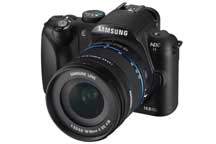
|
Samsung NX500 $799 28.2MP
Why: Basically the flagship NX1 in a smaller body. Best compact interchangeable
lens camera because this is fast, high quality picture and high resolution
along with 4k video. Why not: No viewfinder. Viewfinder would have made
this bigger. If all you intend to use is the 16-50mm f3.5-5.6 kit lens,
seriously consider the Sony RX100 IV. Smaller sensor, but lower f number.
In the end, light gathering ability is the same, but Sony is smaller. Samsung
is $699, Sony is $950. As with all mirrorless, can't focus track an object,
and focus struggles in low light. BSI sensor with on sensor AF detector
along with high power processor helps this camera quickly acquire focus.
1/6,000 shutter with 1/200 sync. 15fps. Tilting LCD. Of course WiFi and
Bluetooth. This is better than Sony because this can record raw files for
greater processing while Sony has a
lossy compressed raw file format, so you loose some data. 287g.
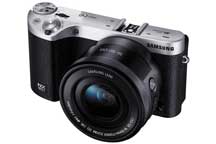 |
Fuji X-T10: $698 Introduced
in 2015 16MP Why: Phase detect focus points on sensor. Flagship X-T1 has
always been weak on focus. This fixes that problem. Strip down version of
X-T1. Why not: As with all focus points on sensor, they don't do well in
low light and as with all mirrorless, don't track an object well. Tilt LCD,
2.36M dot viewfinder .62X (.41X full frame equivalent) magnification, which
is pretty low. 8fps, acceptable 1/4000 sec shutter. Build in flash. WiFi
381g.
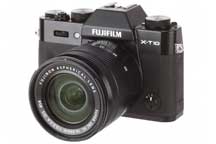 |
Nikon Z50 $856 21MP - Nikon's
first APS-C sized mirrorless. Just to cover all bases. Now they have full
size and APS-C size mirrorless just like Sony. Question is will Nikon develop
the lense for APS-C, or do users have to do with full size lens.
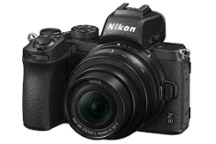 |
APS-C Sized Sensor
DSLR Cameras
Smaller APS-C sized sensor for those who don't
want to pay the price for full frame sensor.
Crop factor 1.6 (1.5 for Cannon)

|
Nikon D300S: (Out of production
and obsolete) $1,696 Why does it exist: Profession quality APS-C
sensor DSLR. 12.3MP Came out in 2009. Full size sensors are prohibitively
expensive back then, so APS-C was an alternative. This is the top of the
line APS-C. The "S" version has video capability. Great auto
focus tracking, tough and durable magnesium case. Is almost like a APS-C
version of the full frame D3 camera. Unfortunately, as full frame sensor
came down in price, Nikon never upgraded this camera. Neither did Nikon
bring more APS-C lens out. People are forced to use full frame sensor
lens that is heavier and larger especially the popular 70-200mm f2.8 that
is a giant for full frame camera. Is hard to say how much smaller it would
be for APS-C, but smaller would have been nice to have regardless. Bloger
Thom Hogan has
preached for years why Nikon, Canon should bring out more APS-C lens.
Now that the pendulum has swung to smaller is better, Nikon and Canon
may finally bring out more APS-C lens because they are smaller eventhough
they are interchangeable with full frame cameras. APS-C lens on full frame
will have dark area on the side, and newer cameras will just crop them
out. Little outdated, but still a viable used camera if you like an older
high end camera for half the cost. BTW, at the time of D300, there was
also D90, which is the beginner's camera, D700, low cost full frame and
D3, professional full frame.

|
Canon 7D: (Out of production)
Why does it exist: This is Canon equivalent to Nikon D300S. 18.8MP
Came out in 2009, and never updated. All magnesium construction. Excellent
and fast auto focus. Very comfortable to hold, the grip is excellent.
This is the highest level APS-C Canon camera in terms of solid construction.
Sensor score may be somewhat lower
than current generation of Nikon cameras like the D7100, but about just
as good as current generation of Canon camera like the 70D. Canon have
somewhat lower sensor scores than Nikon. This does not have as many features
like on sensor phase detect focus like the Canon 70D, but still pretty
good sensor. If you need a durable camera with solid fast focus, this
is it. Little outdated, but still a viable used camera if you like an
older high end camera for half the cost.

|
Nikon D7000 (Out of production,
and replaced by D7100, but should still consider this): $600-$700
Came out in 2010 Why does it exist: One step down from professional APS-C
format D300S. 16.2MP. In reality, the
sensor score on D7000 is higher than D300S. D300S is a more rugged
professional camera with better auto focus. D7000 already has pretty good
autofocus and can track an object pretty well. Camera has partial magnesium
housing and somewhat of weather proof seal. Only problem with the magnesium
housing is the critical part where the metal lens mounting ring screws
onto is plastic. Wish Nikon put magnesium in this critical high stress
front lens mount area instead of putting magnesium in the back of the
camera. Why?
Compare with the camera that is one step lower, the D5300 does not have
magnesium housing or weather seal. Also this has focus motor in body for
older lens that D5300 does not. Most importantly, has auto focus micro
adjustment that the lower D5300 does not. D7000 has now been replace by
D7100.
The reason I bring up the D7000 is because this is a sleeper, and still
a camera to consider today. Sensor has a score of 80 compare with 83 for
D7100, so sensor is just as competitive as the newer model. D7000 has
only 16.4MP compare with 24.3MP for newer D7100. Some people actually
sold
their D7100 and bought the D7000 again because of lower pixel count
that results in better light gathering ability for dark shooting. Nice
to have smaller file size of the 16.4MP also. Newer is not always better.
Seriously consider this over the newer D7100 since there are some old
stock that are at steep discount. High end camera for low cost.
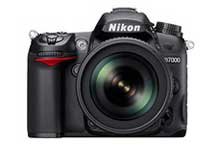
|
Sigma SD1 : $1,828 15MP
Came out in 2012 Why: Foveon X3 sensor. Red, blue and green photocells
are stacked on top of each other instead of individually spread over four
squares in a Bayer mask pattern. Makes for super sharp picture that even
D810 with 36MP cannot quite match. Lines and shapes are crisp and sharp.
Why not: Picture quality unacceptable after ISO 800. Range is 100-6400,
but at 6400 why bother, can hardly make out the details. For this camera,
acceptable autofocus speed, no liveview and no movies. Great magnesium
build with weather seals. Very slow 15sec write
speed, but has buffer for 7 frames. Main shortcoming is ISO noise, but
incredibly great pictures that even Nikon D810 cannot beat.

|
Canon SL1 (100D):
$499 Came out in 2013 Why does it exist: Smallest DSLR camera to compete
with mirrorless. Why not: Picture quality is poor, so not recommended.
Came out in 2013. At 407g, is also the lightest. This is a partial attempt
at going up against the mirrorless camera that are smaller and lighter.
It actually weights about the same as a similar mirrorless cameras. Sony
a6000 is 344g versus this is 407g. The difference is a car remote and
a key. However, Canon for whatever reason put an obsolete sensor in the
camera that performs no better at high ISO than a smaller sensor Micro
4/3 cameras. Maybe Canon was afraid if consumer latch onto lighter cameras,
they will have to trim weight a cross their entire line-up. So Canon made
this an under performing camera. Hope this is not the Kodak syndrome that
caused their downfall will film.

|
Pentax K-3: $1,196 Introduced
in 2014 Why does it exist: Pentax camera have excellent build quality
that last a long time under tough conditions with weather seals. Why not:
Autofocus and tracking for Pentax is typically slower and less reliable
than Nikon and Canon. Top of the line Pentax. Interesting use of image
stabilization to induce blur. The induced blur is used instead of anti-aliasing
filter. Effectively a variable anti-aliasing filter. Pentax does not make
a full frame DSLR. (However, they do make a huge 645Z medium format sensor
camera with 51MP.) Pentax DSLR to take advantage of it's vast amount of
excellent legacy lens. Some say their lens are better at color rendering
than Canon and Nikon. Came out in late 2013. Pentax has always been behind
Nikon and Canon. However, Pentax offers better construction, more durability
and better weather seal than Nikon D7100 and Canon 70D for the same price.
This is equal to the Nikon D300S and Canon 7D that was never updated,
but this Pentax is up to date and performs well. 24MP. Pentax has a good
selection of pancake lens in a good range of focal lengths that can make
for a very compact camera. Their fast normal zoom is 16-50mm f2.8. Canon
and Nikon fast normal zoom is 17-55mm f2.8. That extra 1mm is very needed.
It allows for a true 24mm equivalent wide angle shot. The only downside
is Pantex 16-50mm is not as sharp as Canon and Nikon wide open. Something
about a 16-50mm f2.8 zoom lens that is hard to make. The Tokina 16-50mm
f2.8 for Nikon and Canon is also not very sharp wide open. Is no longer
in production either. Pentax is actually a very good deal. People in the
know get the Pentax for its durability and quality construction.

|
Pentax K-5 II, K-50, K-500: Why does it exist: Pentax
has better features and sturdier builds than Nikon and Canon at a lower
price. Why not: Autofocus and tracking for Pentax is typically slower
and less reliable than Nikon and Canon. Pentax has, less lens choice because
is less well known. Price: $696, $646, $399 respectively. K-5 II vs K-50:
7fps vs 6fps shooting speed. 14 bit Raw vs 12 bit raw color resolution.
Magnesium vs plastic. K-50 still has weather-resistant seal, while the
bottom of the line K-500 does not. Pentax also has an older K-30. K-50
is almost identical to K-30, but updated. The K-50 has dual dial 100%
view finder. Very good at this price range. Pentax are good value, even
the K-500 has a penta prism for the viewfinder instead of pentamirror
mirrors like the Nikon D3300 at the same price point.
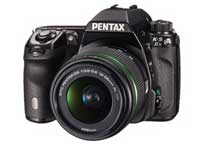 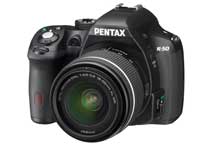
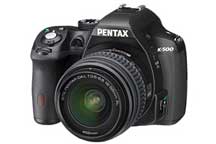
|
Pentax K-S1: $646 20MP
Why does it exist: Mid level DSLR. Sharp lines on the body, and flashing
LED lights on the grip to be unique.
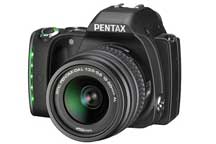 |
Nikon D3300, D5300, D7100:
$596, $746,$1,096 All have 24.2MP Why does it exist: These are the mainstay
of Nikon's APS-C DSLR lineup. This is the standard camera that enthusiasts
would go for. Why not: If you are not shooting moving object, mirrorless
cameras are little smaller and slightly lighter. If you are not shooting
low light, consider M4/3 cameras for smaller package at slight reduction
in image quality. They have been upgraded over the years. In general,
D3300 and D5300 are meant for slow low cost lens. Only D7100 is meant
for fast lens with shallow depth of field because only D7100 has focus
finetune needed for very shallow depth of field fast lens. D3300 is the
entry level department store DSLR camera. D5300 is start of prosumer level
DSLR camera. D5300 mainly has more auto focus options, and 39 point auto
focus instead of 11. It can use wireless flash if you get the Nikon high
end flash that can act as a master. This is where a hobbiest photographer
would consider getting as a second camera. D7100 is right in the prosumer
market. It has two dials for fast control, and very good auto focus. D7100
also has partial magnesium case, weather proofing seals, focus drive motor
for older lens and micro focus adjustment. Focus adjustment is very important
for older lens or third party lens. A lot of times a lens always focus
too far or too near, and this will solve it instead of going to the repair
center that sometimes still does not get it right. D7100 in addition can
use its build in flash as the master to control other Nikon slave flash.
With the D7100, you don't have to get the expensive flash that can act
as the master like with D5300. Note that the sensor rating for all three
cameras are about
the same. They all have same amount of high ISO noise. Higher cost
D7100 has the most dynamic range followed by D5300 then D3300. Lowest
cost D3300 has the highest color sensitivity. D3300 is a very competent
camera even if it has less features. 1/8000 shutter and 1/250 flash sync
for D7100 1/4000 and 1/200 flash sync for D5300 and D3300.
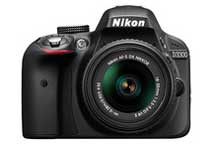 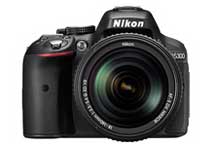
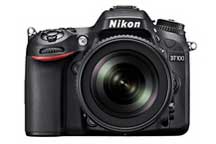
|
Canon T3i (EOS
600D or X5), T5i (EOS 1200D or X70),70D:
$499, $599, $1,099 Why does it exist: These are the mainstay of Canon's
APS-C DSLR lineup, the standard that enthusiasts would go for. Why not:
Canon typically score slightly lower on image quality than Nikon, but
have very good lens selection. These are the Canon equivalent of Nikon's
D3300, D5300 and D7100. Even the weight of each corresponding cameras
are about the same. In general, T3i and T5i are meant for slow low cost
lens. Only 70D is meant for fast lens with shallow depth of field because
only D7100 has focus finetune needed for very shallow depth of field fast
lens. As with Nikon, the 70D is prosumer, and the only one with focus
micro adjustment. Unlike Nikon 70D does not use magnesium whereas Nikon
D7100 has partial magnesium. Both have weather proof seals.
In general Nikon sensors are rated somewhat higher than Canon per DxOMark
which does extensive measurements.
Note that 70D is the first camera to have phase detect auto focus on the
sensor. This gives it excellent auto focus in live view mode where you
use the LCD monitor to shoot instead of viewfinder. That means it has
excellent focus in movies as well. None of the Nikon DSLR has integrated
phase detect focus on the sensor.
T3i is baseline. With Canon, even the baseline model can use its flash
to remote control Canon flash. Nikon need to go to the 3rd level with
the D7100 to do that. Articulated LCD. 4fps speed, 9 point auto focus.
Next level up, T5i adds phase detect on sensor cell. However, review shows
it was not very effective. 5fps shooting speed, same 9 point auto focus.
Touch scree LCD on T5i. 70D adds: Weather proof seals, but still plastic
housing. Auto focus micro adjust. Very effective autofocus detectors on
the sensor for movie and liveview. No second card slot like equivalent
Nikon D7100. 19 point autofocus. WiFi to talk with iPhone. 7fps speed.
70D is good choice for movies except for the fact there are limited STM
lens. STM series of lens have silent autofocus. 70D with STM lens has
incredibly fast autofocus even with movies.
In terms of
sensor performance, T3i and T5i perform about the same, but 70D has
higher score, and better in high ISO as well as dynamic range. Regardless,
Nikon series of DSLR, the D3300,D5300 and D7100 all exceed these Canons
in sensor ratings. Even the lowest cost Nikon D3300
is better then the highest cost 70D Canon. Comment on the forum is
that Nikon has the technology, but they are not good at marketing. On
the flip side, there are other comments that Nikon renders all the colors
more on the orange side, but Canon is more balanced and artistic.
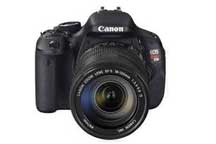 
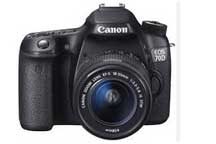
|
Canon 7D Mk II :
$1,799 2014 Introduction. Why: Only pro quality APS-C camera on the market.
Why pro quality: All magnesium construction, 65 point cross type focus,
10 FPS burst mode. Why not: Nikon D7200 is its competition. Better image
quality, but not as good build. Focus cells on sensor. With the kit 18-135mm
f3.5-5.6 STM lens, autofocus is shockingly fast, reliable and silent.
While people lament that Nikon no longer update the D300, Canon brings
out the 7D MkII. This is the Canon equivalent of the Nikon D300. The original
7D came out in 2009, about the same time that the Nikon D300 came out,
and both were getting long in the tooth. This will compete strongly with
Nikon D7100, which has slower frame rate, plastic front side, but potentially
better picture quality. As with Canon DSLR, dynamic range is not as good
as Nikon.
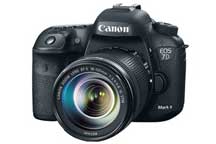
|
Nikon D5500: $796 24.2MP
Why does it exist: Update to D5300. Major news is the feather weight of
420g with battery. This brings the camera down to mirrorless territory.
Why not: Mainly meant for low cost slower lens. More expensive fast lens
with good light gathering ability also has shallow depth of field, and
require focus adjustment for sharp pictures especially third party lens.
This camera does not have focus adjustment, so shallow depth of field
may be an issue if you are not lucky enough to get a perfect lens match
with the camera. Nikon lens are typically very well match, but third parties
like Sigma or Tamron may have to be sent in to match for you. Major issue
for fast lens if you are a discriminating photographer. No low pass filter
on sensor, and articulating LCD screen. Build in wi-fi. Focus tracking
ability of DSLR with light weight of mirrorless makes for a very nice
camera.
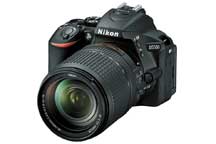
|
Nikon D7200: $1,100
24.2MP Why does it exist: Update to D7100. Fixes two major complaints:
the shallow buffer of D7100 and fix
color banding of Toshiba sensor under certain specific condition but
Sony sensor slightly more noise. Buffer can capture 18 raw files instead
of 6 raw files. Better autofocus with 51 focus points to compete with
Canon 7D Mk II. Build in wi-fi. 675g weight. This is the top of the line
crop sensor DSLR Nikon has. Now comes with very high performance autofocus
that surpass any mirrorless. User comment is autofocus tracking on D7200
is better than Canon 7D. Larger and slightly heavier than mirrorless,
but better autofocus. Large size viewfinder 100% .94X (.63X Full Frame
EQ).
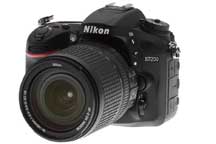
|
Canon 750D (T6i) / 760D (T6S):
$750 / $849 24.2MP 555g / 565g Why does it exist: Finally a 24MP sensor
instead of 18MP. Added Hybrid CMOS AF phase detection on sensor for focus
speed during live vew and movies. Articulating LCD. 5 fps. 19 instead
of 9 AF points in viewfinder mode. Flash sync 1/200sec. Wi-Fi. Viewfinder
95% coverage at .82X (.51X Full Frame EQ), is somewhat small. Intersting
high dynamic range HDR video. Proprietary algorithm that will capture
both bright and dark area in the scene.
760D: In addition to 750D: LCD on top plate. Add a rotary ring on the
directional selector for scrolling thru menus. Hybrid CMOS AF III instead
of AF. Allow for continuous focus tracking while in live view shooting.
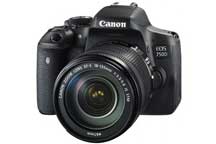 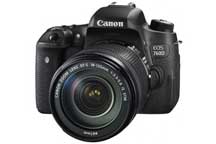
|
Canon 7D Mark II Introduced
2014 Updated version of 7D. Faster focus, but people are in general not
too impressed.
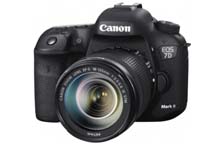
|
Canon 80D Dual pixel
sensor for fast autofocus in liveview mode.
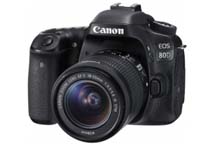
|
Nikon D500 - 20MP $1900
Introduced Feb 2017. APSC photographers have been clamoring for a professional
APSC camera like the D300 from years ago. Nikon has been disappointing
them year after year, but is finally here. 153 cross point autofocus that
covers almost the entire screen. Very large 1.0x viewfinder (.67 full
frame EQ) No build in flash. First time, Nikon with power aperture. Can
change aperture in liveview mode when shooting movies. Previously aperture
is fixed once mirror is up.
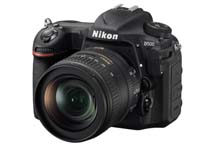
|
Nikon 7500 - 20MP $960
Similar to autofocus capability as the D500. Same sensor as D500. Has
180k metering sensor. 51 point autofocus more or less center of the screen
instead of entire screen on D500.. That is more than the D810 and more
than enough for eye tracking and subject tracking in difficult conditions.
4k video, but at 2.25 crop. No more dual card slot, only one slot. .94x
viewfinder. Build in flash. Has power aperture in liveview mode like the
D500.
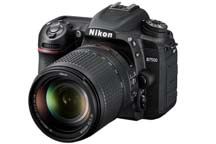
|
Full Frame Sensor
- Both DSLR and Mirrorless Cameras
Traditional sized 35mm full frame camera is the
gold standard in image quality for both ISO and dynamic range. Shallow
depth of field for subject isolation when needed.
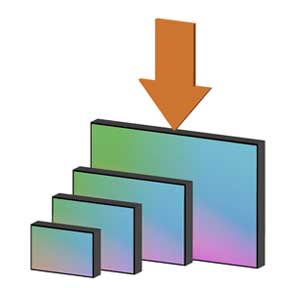
|
Nikon D700 - (Obsolete, no replacement)
Came out in 2008. Full frame camera in a professional full magnesium, but
compact body that is the same as the D300 APS-C camera. Both the D300 and
D700 are greatly loved by fans, but Nikon never updated these two cameras.
Theory was that these two cameras were so much like professional cameras
like the D3 and latter D4 that it cannibalize sales of their professional
line.
 |
Nikon D600 - (Obsolete, replaced
by D610) Came out in 2012 $1,600 24.3MP Why does it exist: First
affortable full frame sensor camera from Nikon. Canon not to be outdone,
announced their 6D weeks latter. This was replaced by the D610 due to oil
issues from the shutter assembly getting onto the sensor. It was such an
issue that Nikon had to change the camera name when they fixed the issue.
D600 owners should get a free shutter assembly replacement especially if
you are the original owner.
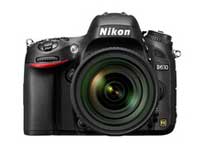 D610
shown, D600 similar. D610
shown, D600 similar. |
Canon EOS 6D Came out in 2012 $1,899 Why does it exist:
First affortable full frame sensor DSLR from Canon. Came out in 2012.
Pretty light at 770g. Use to be, to get full frame sensor camera, you
have to go with the EOS 5D Mark III that cost $3,399. Now full frame camera
price has dropped to less than $2,000. The body of this 6D is based on
the APS-C sensor 60D. 60D has been upgraded to 70D currently. Because
is base on the small sensor 60D, the autofocus points are clustered more
towards the center. This is similar to Nikon D600 full frame camera. Magnesium
body with plastic top plate to allow the WiFi and GPS to work. Note this
camera does not have a build in flash.

|
Sony SLT-A99: $2,298
Came out in 2012 Why does it exist: Full frame camera from Sony. Full
frame version of the Alpha translucent mirror camera. Came out in 2012.
High ISO quality
is not that good, and image is noisy by today's standard. Most people
would get the full frame Alpha 7 mirrorless camera now.
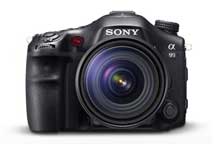
|
Nikon D800 (Obsolete, replaced
by D810) $2,997 Came out in 2012 Why does it exist: 36MP High
resolution full frame camera that is affortable.

|
Canon EOS 1D X $6,799
18.1MP Came out in 2011 Why does it exist: Full frame, Super fast auto
focus and build like a tank for professional. 14FPS speed.
Canon EOS-1D C $11,999 18.1 MP Came out in 2012 Why
does it exst: Exactly like 1DX, but add 4k video. Use APS-H 1.29 crop
factor to record 4k movies. Note: Frame rate is 24P instead of 25P common
in Europe. This camera has stiff competiton from Panasonic GH4 M4/3 sensor
camera. Panasonic has way better autofocus, features like focus peaking
and zebra. This has a much larger full frame sensor for low light performance.
No build in flash. Class leading large .76x view finder.
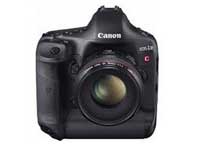
|
Canon EOS 5D Mark III
$3,399 22.3MP Came out in 2012 Why does it exist: True full frame camera
that is a notch down from 1D. Popular choice for filmaking with manual
focus. Autofocus is too jerky. Slower autofocus than 1D. This is similar
to D800 for Nikon, but no build in flash.
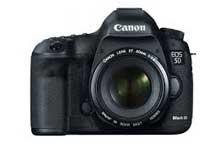
|
Nikon D610: $1,896 Came
out in 2013 Why does it exist: Low cost full frame sensor camera. Replace
D600 that had oil on sensor issue. Body base on D7000. Auto focus sensor
clustered in the center of viewfinder because the AF module came from
an APS-C camera, most likely the D5300 to save cost. 850g

|
Nikon Df: $2.746 Came
out in 2013 Why does it exist: 16.2MP on a full frame camera means it
can capture light very well. Can almost shoot in the dark with a fast
prime lens. Also is a retro camera with multiple dedicated marked knobs
on the top for quick adjustment. Unlike the unmarked knobs that other
high end camera have where you have to look at a screen to tell what the
numbers are at. Down side is this camera still use auto focus from the
smaller APS-C sensor D5300 with the result that focus points are clutered
in the middle of the viewfinder. Also, there is no video feature on this
camera. Some people complain about these two points especially given the
cost that is close to D800. Partial magnesium case. Top, back and bottom
are magnesium. Ergonomics wise, this is a great handling camera and light
for a DSLR at 760g. Controversial camera, but people who use it seems
to
absolutely love it. Note that although this is a light camera, it
has no build in flash, so weight adds up if you have to carry an external
flash.
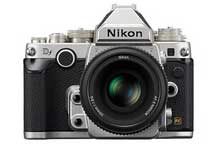
|
Sony Alpha 7(Obsolete), 7R and
7s: $1,498, $2,298,$2,498 Why does it exist: Mirrorless interchangable
lens camera with full frame sensor. Small size of mirrorless with full
frame sensor. It is what people has been asking for. However, this is
where things get very confusing with naming. This "Alpha" camera
is not the SLT-A99 full frame camera that people also call the alpha because
SLT-A99 has a greek alpha symbol on the camera. Difference is here the
name is spelled out "Alpha" while the SLT-A99 camera has the
"SLT" acronym in its name. Alpha 7,7R and 7s are full frame
mirrorless camera. The 7 is 24MP, 7R is 36MP and 7s is 12MP. 7 is the
middle of the road full frame camera at 24MP. However, 7s only have 12MP
because it is for low light. Less MP on the sensor means each pixel is
larger, and can gather more light. Better low light performance. 7R with
36MP is to compete with latest Nikon and Canon that have high pixel count
for bragging rights. You suffer in low light condition though. Sony has
the 3 variation just to cover all bases. Viewfinder magnification is .71X.
Autofocus is not this camera's strenght. Is somewhat slow. The 7R shutter
is
very loud as noted by several users. A7 should not be loud though.
Need a $800 XLR-K1M adaptor to record cinema quality 4k movie. A7 focus
speed is faster
than A7R.
Alpha use NEX lens, but now the NEX lens mount are split into two category
APS-C or full frame. If is Sony E, the lens is smaller APS-C. Use that
lens on this camera, and only part of the sensor will be used. Use Sony
FE lens, and camera will use the entire full frame sensor. Of course,
the Sony FE lens are heavier than the Sony E. Note issues with mirrorless
lens.
See half way down the page. Note that Sony make some of the best sensors
out there because they have deep pockets. Other manufactures even Nikon
and Canon use Sony sensors for some of their cameras. Do note that Sony
RAW
file format is compressed, and some picture information is lost. Sony
files are not as good as other RAW files.

|
Nikon D810 $3,296 Introduced
in 2014 36MP Why does it exist: Base ISO of 64! No other camera has that
low ISO. More expensive to make, but result is less noise and more dynamic
range at ISO 64. Many consider this to be the absolute best camera you
can buy for image quality short of going to medium format. Price is less
than that of professional full frame cameras like D4s. Giving up build
qulaity compare to D4s. Expanded ISO range down to ISO 32. Much lower
than the typical 100. Great for long exposure shot of waterfall or ocean
to get the image of the water to blur, and have the dreamy cloud like
look. .7x viewfinder. Also has an option for 12-bit instead of 14-bit
color gradiant to reduce RAW file size to 9MB. The full 14bit files is
75MB uncompressed, or 43MB lossless compressed. You can of course choose
JPEG for much smaller file size. All magnesium case. Unlike the Canon
full frames, or even Nikon's Df and D4s professional full frame models,
this has a build in flash. Build in flash may be considered too consumerish
for the pro D4s. This has a very quiet shutter sound. Shutter designed
for minimal vibration because 36MP is very sensitive sensor. Slight vibration
will blur it. Has a 91,000 pixel metering sensor high enough pixel for
face recognition. The $4,500 Zeiss Otus 85mm f1.4 and 55mm f1.4 manual
focus lens are made specifically for this camera. Super sharp lens to
take advantage of the 36MP resolution and 64 ISO. That would be the ultimate
combination. 980g

|
Nikon D4s $6,496 Introduced
in 2014 Why does it exist: Full frame. For sports, has the absolutely
best auto focus and high frame rate. Also very rugged for professional
use. The build makes all other cameras even the D810 full frame seem like
amatures. This is truly a professional tool. Is also large and heavy.
Also note that this camera does not have a build in flash, so it truly
is a professional model that expects you to carry a separate flash. Has
new sRAW
file format for reduced file size.
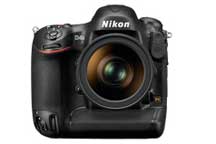
|
Leica M9 $6,895 18MP Why:
Leica rangefinders makes great cameras for protraits because of their great
lens. The render skin tone very well. Dial for each function laid out in
logical manner base on classic Leica design. Dial has un-equal detent spacing,
so you know where you are at by feel without looking. Smooth manual focus
lever is very fast with practice. Buy Leica for the excellent lens and not
the camera. Nothing else can match their lens. Is not the best value for
the dollar, but the the experiance is unique. Is like Aston Martin vs Corvette.
One has character, the other value for performance.
Good 3D depth "pop"
Superceed M8 and M8.2. Finder magnification is .68x versus .72x for film
M7 or legendary film M3 at .91x. Shutter button gritty.
Use metal instead of the classic cloth mechanical shutter.
 |
Leica M-E $5,450 18MP M9,
but strip down. No USB socket and preview lever;
M9-P $7,995 M9, but upgraded. Added sapphire crystal LCD;
Leica M9 Titan Limited Edition Set $26,500 M9, but premium edition.
Solid titanium construction w/ 35mm f1.4 ASPH lens.
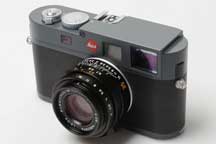
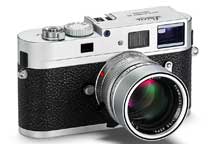 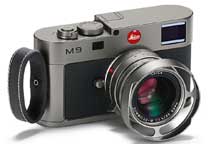 |
Leica M9 Monochrom $7,950
Why black and white only: Monochrom takes out the bayer color filter array
in front of the sensor. Several good results comes out of that. Sensor is
not divided into different color cells. No loss of detail when colored light
strike the wrong color cell, and camera can't resolve the light's exact
position. This is similar to Sigma's Foveon sensors. The details you get
is amazing, and is not the same as going to a higher number of pixels. The
look is not the same. Monochrom sensor results in very good details. Color
filter blocks 2 of the 3 colors and only let in one. A lot of light is being
blocked out. Without color filter, sensor gets much more light resulting
in excellent high ISO image.
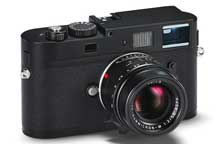 |
Leica M Type 240 $6,950
24MP Updated model to M9. Use CMOS sensor instead of CCD of M9. Microlense
with strong curvature along with short distance between microlens and sensor
maximize
quantum efficiency at high ray angles. Use 110/90nm CMOS process. This
allows the camera to use full range of Leica legacy wide angle lens, and
not get blocked light rays at the edge. This is the same issue with all
mirrorless. With film, light can come in at any angles, and film will capture
it. With digital, light need to be straight on as possible for maximum capture.
Wide lens designed for film have light ray coming in from the edge of the
lens. Digital sensor cannot capture the light coming in from the side edge
of the lens. This sensor tried to use high curvature lens to capture light
rays from all angles.
Optional $499 Leica EVF-2 1.4M-dot viewfinder. Is same as the outdated Olympus
VF-2 viewfinder. EVF allow use of camera even if manual range finder focus
has drifted. EVF is too laggy.
Live view with focus peaking. HD video. Smoother shutter and weather sealed.
Still not as good as old M3. .68x viewfinder. All European made including
sensor.
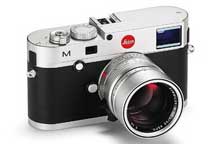 |
Nikon D750 $2,299 Introduced
in Sep 2014 24MP Why: One level above D610. First for Nikon: tilt screen
LCD. Features: In addition to D610, faster, more accurate autofocus with
51 points focus that is same as D810. D610 only has 39 points that is
towards the center because the focus sensor likely came from D7100 that
has a smaller APS-C sensor. Autofocus is also better than D810 in that
is rated to -3EV low light. WiFi, tilting LCD. Carbon fiber reinforce
plastic front instead of just plastic. Same magnesium back. 6fps. Buffer
improved from 57 image to 87 jpg images. .7x viewfinder. 1/4000 shutter
and 1/200 flash sync similar to D610 compare with D810 with 1/8000 shutter
with 1/320 flash sync. Shutter is louder than D810. Some complaints about
the shutter noise. Considered jack of all trade for full frame DSLR cameras.
750g.
D750 is a great upgrade to D610 because of the improved autofocus that
people did not like about D610.
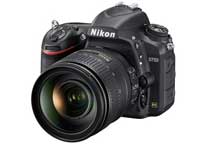 |
Sony Alpha 7II: $1,498,
24MP. Same as original A7, but with 5-axis sensor image stabiliztion,
and has better autofocus. Shutter is loud, but just slightly
too loud, and.not obnoxiously loud like on 7R.
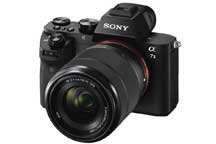
|
Sony Alpha a7R II: $3,200,
42.4MP. Why: Focus points on sensor for faster focus and potential focus
tracking. BSI sensor not for light gathering, but for faster readout.
5 axis stabilization. 4k video. Huge .78X electronic viewfinder. Why not:
Short battery life. Sony has limited lens line-up. High ISO noise slightly
worse than Nikon D810. Although dynamic range is slightly better.
Third party lens can have compatibility issues. Not as good focus track
as DSLR.
Too many fake users who are marketing shills singing praise for this camera.
Here is the low down:
Everyone wants to know autofocus performance. Can it finally equall DSLR:
Autofocus in good light is very fast as is typical for mirrorless of this
generation.
In dark
environment, have to use a fast lens to get good autofocus. Otherwise,
it hunts and is no good.
Is
not very good for sports. Multiple players confuse the autofocus.
Can focus a Canon lens as fast as Canon DSLR with Metabones adaptor. HOWEVER,
with the adapter, you are closing in on weight of DSLR and size, and not
all focus modes works. Adapter is additional $400.
Great for video, because focus in video mode is way better than DSLR and
viewfinder is useful for video.78X EVF is very large. Bigger than all
DSLR. However, EVF does have washout issues in certain high brightness/darkness
environment. Lastly, mirrorless may be small, but lens will be pretty
much the same size simply due to optical physics. Smaller body, but may
have to carry extra battery.
DSLR can shoot all day with a partially charged battery. Not mirrorless
though. Need to charge battery before leaving the house. Keeping a
battery fully charged is bad for its life and cause it to to loose
capacity. OEM batteries are expensive at $50. Note that aftermarket ones
are cheap, but poor quality. They are often rejects from manufactures
for various reasons.
Sony zoom lens for full frame camera are expensive, not fast at f4, and
of poor quality. Sony prime lens are good quality. Beware that Sony prime
lens say Zeiss, but are not as good quality as "real" Zeiss.
Obviously you get what you pay for. More lens should be coming though.
625g.
Competition is Canon 5D or Nikon D810. D810 body is 980g so is .75lbs
heavier, but lens will be about the same. D810 you get base ISO 64 instead
of 100 for one stop better picture quality. Of course, Nikon and Canon
has many more native lens than Sony.
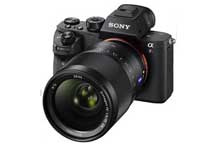 |
Canon EOS 5DS and 5DS R
$3,700/$3,900 50.6MP Why: Ultra high resolution full frame camera. 5DS R
deletes the anti-alias filter for sharper pictures. .71X viewfinder, 5fps,
1/8000 shutter, 1/200 flash sync. Fixed LCD. No 4k movies, no WiFi. Good
high resolution camera. 930g
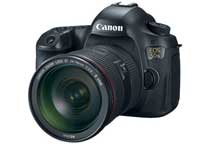
|
Sonly Alpha a9 $4,500
24MP. Sony's top performance mirrorless. Claim to fame is again fast autofocus.
fast 20 fps, longer 650 shot battery life. Sensor can read out in 1/160
sec. in silent mode. This minimize distortion when subject is moving.
Autofocus is probably as good as DSLR. Question is whether is as good
in dim light conditions.

|
Nikon D5 $6500 20.8MP
Launced in Feb 2017 As mirrorless is improving on autofocus, Nikon uppened
the ante and came out with a professional DSLR with blazing fast autofocus.
Hands down beats Sony Alpha a9. 153 focus dots. .72x viewfinder Base ISO
50 180k RGB sensor that have good object recognition.
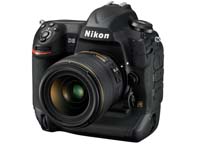
|
Nikon D850 $3300 45.7MP
Launch Aug 2017 Have same autofocus processor as the D5. However, autofocus
is slower than D5, but still very fast. For the non-professional photographers
who do not want to spend $6k for a camera. Excellent picture quality,
one of the best. Very low ISO50 base ISO.

|
Sony Alpha A7R III $2,600
42MP Incremental improvement. Faster processor, better autofocus and faster
burst rate of 10 fps. Larger capacity battery. 3.69M-dot viewfinder.
Sony Alpha A7III $2,000 24.2MP Launch April 2018 Sensor
readout is 1/18sec in silent mode. Sensor based 5 axis stabilization.
No digital stabilization. Autofocus based on a9, so expect fast focus.
2.36 mil dot viewfinder .78x. Increased battery size and grip size. Allow
for 600 pictures per charge. This is finally serious challenge for DSLR.
However, Nikon D850 also improved its autofocus, so the goal post is moved.
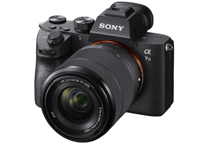
|
Nikon D780$2,790 25MP
Launch Jan 2020 - DSLR with fast focus in live view video. Uses the focus
algorithm in Z6 mirrorless camera. Now is best of both worlds. Mirrorless
autofocus speed for video and performance of DSLR for still. One thing
missing is electronic viewfinder in video mode. Nice for older people
with farsighted vision :)
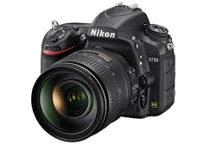
|
Nikon D6 $5,500 24.2MP
20.9MP - DSLR Speed deamon camera for professional sports. Nothing can touch
it in autofocus speed. Big and heavy with only 20.9MP, but does the job.
 |
Nikon Z6 $1,796 25MP
- Low end brother to the Z7.
 |
Nikon Z7$2,796 45.7MP -
Equivalent to the high resolution D850, but in mirrorless. Nikon's answer
to Sony A7R. BSI sensor.

|
Sony Alpha A9II $4,500
24M - Sports oriented 20fps without blackout with electronic shutter. Updated
10fps with mechanical shutter. ISO 50-204,800 3.69M-dot EVF. .78x
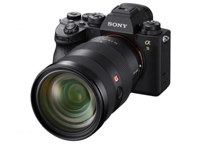 |
Sony Alpha A7R IV$3,500
61MP Released in 2019. Shocking 61MP sensor. Increased to 5.76 M-dot viewfinder.
Autofocus that recognize people even when they turn away. Pixel shift for
a 240MP picture that will also cancel Bayer filter. Results in incredibly
sharp image.

|
Sony a7C $1,799 24MP
- Small size. Hybrid autofocus with real-time tracking similar to high
end products. 5 axis image stabilization. 2.36M-dot EVF .59x
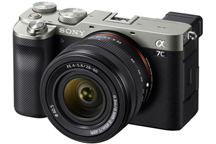
|
Sony a7S III $3,499 12MP
- Good for video, low resolution for stills. 4k video at 120p. ISO 80-102400.
9.44M-dot EVF.
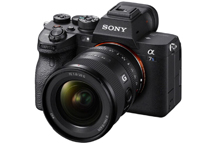
|
Nikon Z6 II $1,995 25MP
- Released on Oct 2020 - Faster 14fps, improved autofocus-better, but slightly
behind best in class, 4k/60p video for APS-C crop.
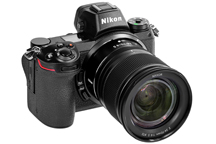
|
Nikon Z7 II $2,999 45.7MP
- Released on Oct 2020 - Dual card slots. Improved autofocus. 3.69 M-dot
EVF .8x.
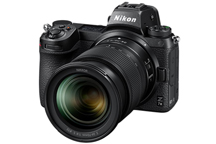
|
Nikon Z9 $5,500 45MP -
Released on Dec 2021 - 30 fps in JPEG or 20 in raw. 8k/30 video. Very fast
read-out sensor no mechanical shutter, and still no rolling shutter distortion.
Means silent shooting and unlimited shutter life. In body stabilization
that works in conjunction with lense. Very bright 3.68M-dot viewfinder at
honest 60fps refresh. (Sony's advertised high refresh rate is only for reviewing
images, drops during tracking and focusing.). Auto focus as good as DSLR
at -5EV sensitivity. For comparison, Nikon's flagship D6 DSLR is at -4.5EV.
Mirrorless truly beat DSLR even in low light.
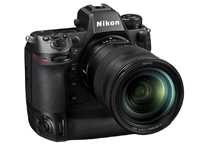
|
| |
High End Fixed
Lens Camera w/ Larger Sensors (1" or Larger)
These are almost viable alternative to DSLR and
Mirrorless interchangeable lens cameras. 1" sensor is starting to
be large enough to be taken seriously.
1" Sensor Crop Factor = 2.7
M4/3 Sensor Crop Factor =2.0
1.5" Sensor Crop Factor = 1.9 |
Sigma Merrill Series:
$708-$750 Came out in 2012 Why: Foveon X3 Sensor. 15MP APS-C size sensor.
Like the SD1 Sigma DSLR, but with fixed focus lens. All three cameras
are the same except with different fixed focal lengths.
For Foveon sensor, red, blue and green photocells are stacked on top of
each other instead of individually spread over four squares in a Bayer
mask pattern. Makes for super sharp picture that even D810 with 36MP cannot
quite match. Lines and shapes are crisp and sharp. However, picture quality
unacceptable after ISO 800. Also very slow
autofocus that takes half to one second, slow writing to memory card,
640x480 movie only, and not very good battery life.
Some complain about the Sigma PhotoPro software being slow. I don't think
so. Download the program,
and use these files
to test yourself.
DP1 Merrill: Equivalent 28mm f2.8 lens.
DP2 Merrill: Equivalent 50mm f2.8 lens.
DP3 Merrill: Equivalent 75mm f2.8 lens.
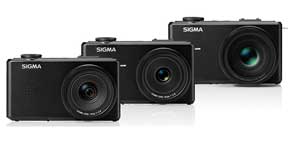
|
Sony DSC-RX1: $2,798
Came out in 2012 Why does it exist: Full frame sensor pocket camera! But
no zoom. Fixed zoom 35mm f2.0 lens. 35mm is half way between 24mm wide
and 50mm normal length. So focal length is on the wide side. That is all
you get, and you can't zoom. There is also a RX1R that does not have the
morie filter for sharper pictures, but at the risk of ailasing illusion
when shooting closely spaced pattern like picket fence. Focus speed is
moderately fast. This camera's full frame sensor is good for cranking
up the ISO for high shutter speed and low indoor light, but with wide
focal length lens, not so good for sports where you need a zoom to get
into the action. Wide lens is also not so good for portrait. Tends to
distort the view and makes people look big and wide. Although full frame
gets you good bokeh to blur the background that is good for portrait.
Wide angle lens is good for landscape, but usually, full frame is not
needed for landscape where you do want everything to be sharp. You have
to close the aperture to make all parts of the image sharp. People do
wonder what is this camera good for. Full frame sounds great, but is not
a strong seller.
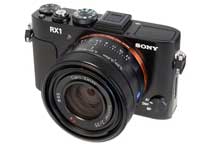
|
Fujifilm X100S: $1,200
16MP Came out in 2013 Why does it exist: Alternative to the $6,900 Leica
M9 range finder camera. This too is a range finder, but is APS-C sensor
instead of full frame. Fixed 23mm f2 lens. Very high quality compact rangefinder
camera. One of the best in rendering skin tone, so this too like the Leica
is good for portraits. Excellent flash with the right tint. Many professional
photographers love this simple fixed lens camera. X-trans sensor that eliminate
need for anti-alias filter. Magnesium construction. Traditional controls
with aperture adjust in the front on the lens just like traditional film
cameras. Hybrid viewfinder with 2.35k-dot display. Viewfinder combines optical
viewfinder for clarity with electronic display. Can overlay focus peaking
or digital split prism on the optical viewfinder. Not horribly fast
auto focus. Camera has been praised for its control layout. The Nikon DSLR
retro Df has often been compared with this camera, but critics in general
like the layout of this camera more. Autofocus is not
very fast. Overall, is a high quality fixed lens camera, but being fixed
lens, its usefullness is limited just like the Sony RX1.
Some people like the simplicity of a fixed lens so you don't end up carrying
an entire bag of lens.
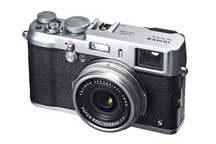 |
Ricoh GR 16.2MP Released
2013. Why does it exist: APS-C sized sensor fixed zoom compact camera. 18.5mm
f2.8 lens. Equivalent of 28mm full frame lens. The equivalent 28mm lens
is the issue here. Is one of those neither here nor there lens. 24mm is
wide, and 50mm is normal because is what your eye sees. This is just right
in between, which is kind of awkward IMHO. No anti-aliasing filter.
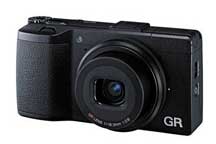 |
Nikon Coolpix A 16MP Released
2013 Why: Another fixed zoom lens camera from Nikon with the success of
Fujifilm X100S. 28mm (equiv) f2.8 fixed zoom lens camera with APS-C sensor.
Similar sensor to the excellent D7000 DSLR. No anti-aliasing filter.
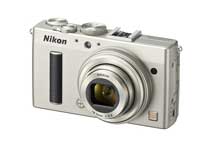 |
Sony Cyber-Shot DSC-RX10
$998 Came out in 2013 20.2MP Why does it exist: All in one super zoom lens
alternative to DSLR if you can accept a 1" sensor. Impressive specs.
Super 24-200mm zoom that is no kidding f2.8 constant. Relatively large 1"
sensor. Optical image stabilization. Add on top of that is a Zeiss lens.
Weights 813g, so is heavy and large like a DSLR than a compact. Top and
bottom are magnesium and is weather sealed. Focus is fast in bright light,
but takes up to a
second in poor light. That can dampen shooting experience. Great for
outdoor sports. No good for indoor sports. Has a viewfinder. Tilting LCD
screen, but cannot do 180 deg. Definitely competition to Nikon1 series of
cameras. Nikon1 has slower f4.5-5.6 equiv. 27-270mm lens, but autofocus
is faster, and can track an object while this cannot. Lack of tracking limits
the use of the super zoom.
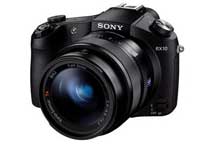 |
Panasonic Lumix DMC-FZ1000
$897 20MP Introduced in 2014 Why does it exist: All in one super zoom
lens alternative to DSLR if you can accept a 1" sensor. Competition
to Sony RX10. Powerful 24-200mm zoom that is relatively fast at f2.8-4.
Also has impressive 5 axis stabilization. 831g weight, and size is more
of a DSLR size camera. Is a serious contender for the Nikon 1 camera.
Like the Nikon 1, autofocus is ultra fast on the camera. It use Depth
of Defocus technology like on the much more expensive GH4 M4/3 mirrorless
camera. However, this camera definitely cannot track focus. You have to
do single shot focus, and assume the object has not moved much. If you
need to track an object like bird or sports, Nikon 1 is the right camera.
Compared to Nikon 1, here you already have the lens that is very capable.
Has a viewfinder. In summary, Sony Zeiss lens is sharper and faster at
f2.8. This has 5 axis stabilization and faster autofocus. Nikon 1 are
much smaller than either one with very fast autofocus, but much slower
27-270mm f4.5-5.6 lens. Nikon1 also lets you change to other lens that
includes the crazy equiv. 189-810mm f4.5-5.6.
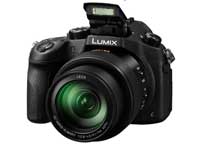
|
Canon PowerShot G1 X Mark II
$799 12.8MP Introduced in 2014 Why does it exist. The biggest 1.5"
sensor that is even 8% larger area than micro 4/3 camera! Powerful 24-120mm
zoom and fast on the wide end f2-3.9 lens. This camera is short of the
super zoom range, but has larger apeture than super zoom on the wide end
at f2, and larger sensor than all the other super zoom. Sensor is 225%
larger area than other superzooms that have 1" or even smaller sensors.
Unfortunately, the sensor may have slightly better high ISO quality, but
not very good in dynamic range compared with sony RX10 or RX100 that has
smaller sensor. Acceptable autofocus speed (.21-.36
sec) except in low light. Sluggish focus in flash mode. Impressive
all magnesium body, and optical stabilization. Wide end at 24mm is not
a fisheye wide, but definitely very wide. Tele end is 120mm, which is
good for portrait and zoom in on action. Tele end is less that true sports
camera 200mm, but most likely adequate if you are not into sports or bird
watching. Weight is only 553g, which is very light for a magnesium body
camera. Pop-up flash. No build in viewfinder. Articulating 180deg LCD
screen. Can use Canon Speedlite flash or Optional $240 EVF-DC1 viewfinder
with 2.36M-dots on the hot shoe, but not both. Using a Speedlite with
master option can trigger multiple flashes. Overall assesment is Sony
RX10 is better. This has slightly better ISO noise, but poor in dynamic
range. Low price, but when you add in viewfinder, is about the same as
Sony, and Sony has f2.8 constant that is longer 24-200mm.
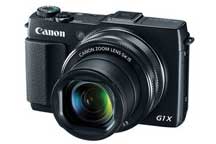
|
Fujifilm X100T: $1,300
16MP Came out in Nov 2014 Why doee it exist: Fixed prime lens APS-C size
sensor compact camera. Upate to X100S. 23mm f2 lens (35mm equiv). Hybrid
viewfinder similar to X100S where shooting information is superimposed on
the viewfinder. This adds a shaded screen that can be moved into position
so information can be clearly seen in all lights. In EVF mode, has super
fast 54fps .005sec lag EVF from the XT1 camera with higher 1.04m dot LCD.
Optional electronic shutter. Added dial in back of camera instead of rocker
switch.
 |
Sony DSC-RX100 III:
$798 20.2MP Introduced in 2014 Why does it exist: About as good as it
gets in small pocket camera. Nice 1" BSI sensor. Zeiss 24mm-70mm
f2.8 lens. This is not a super zoom, but good for low light shooting (for
a compact). A camera that photographer afficionado would actually consider.
The original RX100 came out in 2012. The 3rd version in 2014. 20MP BSI
(Back Side Illuminated) 1" sensor. Wires behind photoreceptor for
better light gathering. Expensive to manufacture, but better
picture quality than normal 1" sensor. 70mm is considered low
end of telephoto, so this is not a telezoom camera, but 70mm is enough
to be somewhat useful, and better than nothing. Pocket sized point and
shoot fixed lens. 24mm-70mm Zeiss lens is good quality and useful range.
1" sensor is larger than your typical point and shoot cameras. Articulating
180deg LCD screen. Same size as Nikon V1 mirrorless camera. Fast lens
and relatively large sensor is good for low light, but still not as good
as 4/3 sensor, and no where as good as APS-C or full frame. Still a good
premium point and shoot that is one level below Micro4/3 cameras. Great
for outdoor. Forget indoor fast action. Reasonable fast autofocus
speed as long as the subject is stationary. Moving subject, forget
about it. -120fps video at 1280x720. 1/2000sec flash sync, but no hotshoe.
Internal flash only.
Competition is Canon G7X and Panasonic LX100.
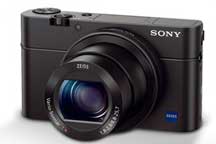
|
Canon PowerShot G7 X
$650 20MP Introduced in 2014 Why: True competitor to Sony RX100 MkIII
Pocketable size, but brighter zoom lens and longer zoom. Magical camera
that seems to do it all. 1" sensor and bright equiv. 24-100mm f1.8-2.8
lens. All in a very small package that is smaller than similar fast lens
large sensor pocket cameras. Very impressive for its small pocket size.
304g WiFi. Build in flash, but no viewfinder. Use the same Sony back side
illuminated (BSI) sensor
as RX100, but dynamic range is about 1/2 stop higher than Sony RX100 III.
Also the lens stay at lower f stop deeper into the zoom than Sony does.
RX100III starts at f1.8 at 24mm, but very quickly goes to f2.8 at 30mm.
This starts at f1.8, but goes to 50mm before it goes to f2.8. - 60fps
at 1920x1080 video
Sony does have Zeiss lens that is sharper. Autofocus on Sony is also faster
and more sure than canon.
1/2000sec flash sync. Articulate LCD.
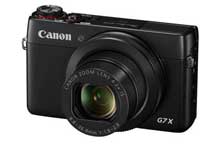
|
Panasonic Lumix DMC-LX100
$899 16MP (12MP Effective) Introduced in 2014 Why: Some incredible specs!
1) Large M4/3 sensor in a compact camera (But does not use the entire
sensor). 2) f1.7-2.8 fast Leica DC Vario-Summilux lens. 3) Panasonic depth
of defocus technology for super fast autofocus. Faster than Sony and Canon.
4) Rare leaf shutter to achieve 1/4000sec
flash sync Most DSLR are only up to 1/250sec. Sony and Canon is less at
1/2000 sec. 5) 4k video.
Note the camera does not use the entire sensor. Realistically, is really
1.5X the area of its competition 1" sensor, and not 1.9X. Still a
large sensor. Also a very fast lens, but not as pocketable as the Canon
G7X or Sony RX100. Equiv. 24-75mm f1.7-2.8 lens. 393g Sensor on this camera
is bigger than the Canon G7X and Sony RX100, and lens zoom is slightly
less. 4k video. 9 blade aperture for better bokeh. Depth of defocus autofocus
algorithm for lightning fast focusing. Has viewfinder, but big downside
is no build in flash, but do come with a small external one, but is unwieldy
to use. WiFi. 2.76M dot viewfinder. This is a strong competition to the
the popular Sony RX100 III and Canon G7X as the best compact camera that
is not a super zoom. In summary, this is bigger in size, and not really
pocketable., But expect
better picture quality, and 4k video. Canon has higher zoom and pretty
much match
this in picture quality for ISO, but this is slightly better in dynamic
range, and smaller size. That leaves Sony that has Zeiss lens that is
sharper than Canon and faster autofocus. Sony does have high speed video
at 120fps. This one is 60fps at 1920x1080 video. This camera has the most
control and customization of all three for professionals. No articulate
LCD screen.
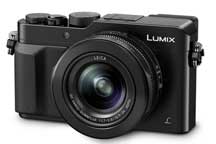
|
Leica D-Lux (Typ 109) Same
camera as LX100, but with Leica "Red Dot" $1,195. Only difference
might be longer warranty. Leica have 3
year warranty rather than 1 year for Panasonic. Also comes with Adobe
Lightroom software worth $139. If you need to get the Lightroom anyway,
then consider this as $157 for extended warranty. You get the painted red
dot too.
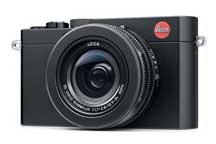 |
Leica X (Typ 113) $2,295
16.2MP Why: Is a Leica camera. Summilux equivalent 35mm f1.7 lens. APS-C
size sensor. Top quality construction from machined billet aluminum, magnesium
and leather.
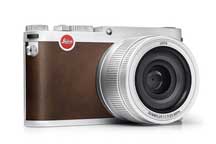 |
Sigma Quattro Series $899
29MP APS-C Sensor Why: Because Foveon X3 sensor, images are nothing short
of breath taking sharp, brilliant smooth color transition. Improvement
from DP2 Merrill. Pretty fast
autofocus, but does not work well in dark.
Write speed is slow at about 8
seconds a picture. ISO acceptable up to ISO 800, then picture quality
degrades quickly. ISO range is 100-6400. Given the image degradation,
no point going beyond 6400 anyway. No build in flash. External flash is
definitely needed on this camera given the ISO.
Camera is not as polished as other major manufacture. More of a start-up
product. People don't like it because high ISO image quality is poor.
Past models autofocus is slow, but greatly improved here. Still, bottom
line, because of Foveon sensor, you will never find better image than
this camera short of a medium format camera if even then. Images are better
than full frame camera, no kidding. This camera is a secret that many
photographers don't know much about. Do seriously consider this.
DP1 Quattro: Equivalent 28mm f2.8 lens.
DP2 Quattro: Equivalent 45mm f2.8 lens.
DP3 Quattro: Equivalent 50mm f2.8 lens. Release date
to be announced.

|
Canon PowerShot G3 X $999
20.2MP Why: 24-600mm super 25X zoom camera size of the thin compact G7X.
Why not: F2.8-5.6 lens is slow on the zoom end. Trade zoom for slower lens.
5 axis image stabilization - a must for his high zoom and slow lens.WiFi.
733g.
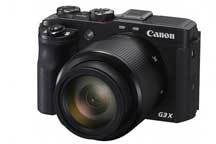 |
Sony Cyber-Shot DSC-RX10 II
$998 Why: Updated RX10. Fast super zoom 24-200mm f2.8. Killer hardware.
Fast focus, fast shutter, fast lens, 4k video and very high speed 960fps
video. Optical image stabilization. Why not: Large size, and as with mirrorless
, do not expect it to focus track. Stacked CMOS instead of BSI. More light
gathering ability and faster readout for framerate. 4k video, also high
speed video of 960fps at 1136x384 resolution! 24-200mm f2.8. 2.35 million-dot
electronic viewfinder instead of 1.44 M-dots. 1/32,000 sec shutter! 813g
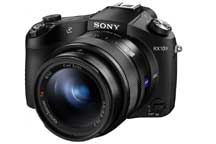
|
Sony Cyber-Shot DSC-RX100 IV
$949 16.8MP This is as good as it gets for the RX100 line. Starts going
downhill and more expensive from here. Why: Small camera with very fast
normal zoom 24-70mm f1.8-2.8. Zeiss lens. That is equivalent to f3.2-5
on an APS-C camera! Amazing light gathering in a package this size. Add
to that killer hardware. Fast focus, fast shutter, fast lens, 4k video
and very high speed 960fps video. Optical image stabilization. Why not:
Can't think of much. Only 1" sensor. (But what do you expect for
pocket camera) Normal zoom instead of super zoom like RX10. Stacked CMOS
instead of BSI. More light gathering ability and faster readout for framerate.
Focus is as fast as .09 sec. Zeiss lens. Added 2.35 million-dot electronic
viewfinder instead of 1.44 M-dots. Tilting LCD. High speed video of 960fps!
1/32,000 sec shutter! 298g
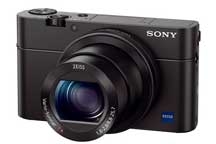 |
Leica Q (Type 116) $4,250
24MP Why: Good deal as far as Leica is concerned. Full Frame 28mm f1.7 Summilux.
If bought separate with Leica M rangefinder and lens, would cost you $13,000.
Why not: Sony RX1 is much cheaper at $2,800. This is a mirrorless, first
for Leica, and not an optical viewfinder camera. Has un-Leica like technology
like biggest 3.68m dots viewfinder, 1/16,000 electronic shutter and 1/2000
sec sync speed. 10fps burst rate. WiFi 640g
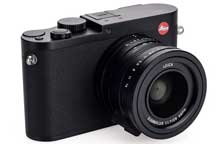
|
Panasonic Lumix DMC-ZS100/TZ100
$700 20.1MP Why: Small size but has good zoom 25-250mm f2.8-5.9. 312g.
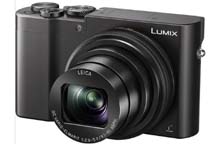
|
Sony Cyber-Shot DSC-RX100 VA
The Sony RX100 is multiplying like rabbit. Claim to fame has
alway been compact size with a standard zoom and fast lens. Recap of the
series. Version I to II has slow lens of F1.8-4.9. Version III to V has
fast lens of F1.8-2.8. By version IV, hardware hits it stride with fast
autofocus. Fast meaning like DSLR fast in good light, not in dark. Version
IV also has slow motion video of 960fps. Fun taking picture of water drop
falling or house of card falling down. Version V has added on sensor phase
detection for faster autofous which is good, but reviews are mixed. Battery
life gone down. 350shots on ver II to 280 for the best ver IV to 220 for
version V. Slow motion at 1000fps 1244x420.
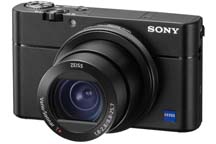
Version VI has gone downhill even more. Lens no longer as fast at F2.8-4.5.
But zoom has gone up to 24-200mm. Len speed is worse than version I. Tradeoff
speed for more zoom. You have more light in previous version, just have
to crop the image instead of using zoom lens. With zoom lens, you get
more resolution, but less light. So only good in bright daylight. Version
VI has faster autofocus, but mirrorless is not a DSLR, electronic viewfinder
has lag, so not good for fast action anyway.
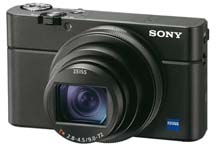
|
High End Fixed
Lens Compact Camera w/ Small Sensors (Smaller than 1")
These are the traditional compact cameras with
small sensors. However, these top of the line models have fast lens or
super zooms to make them appealing to the enthusiasts. Their advantage
is compact pocket size.
Two size of sensors are included here:
1/2.3" Sensor Crop Factor = 5.6
1/1.7" Sensor Crop Factor = 4.6.
See graph below. Note that at sensor size smaller
than 1", the image quality is not that much different than an iPhone.
Keep that in mind. You may be better off just carrying an iPhone. Of course,
these cameras may have a higher range zoom lens. There are some advantage,
but not enough to justify carrying another device.
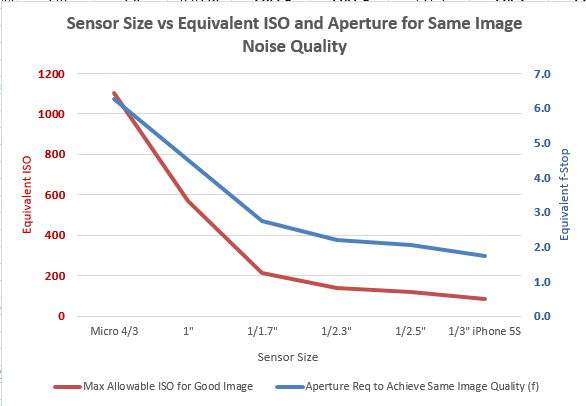
|
Canon PowerShot S110 12.1
MP $249 Why: Very compact, but not very bright lens. Equivalent 24-120mm
f2-5.9 1/1.7" sensor. 173g. Canon started with the obsolete S90 in
2009. It was ground breaking because this is a point and shoot with f2.0
lens at least on the wide end. Took very nice pictures for its days. Many
cameras have since followed suit. Still a good small compact camera. Its
price has been pushed down because of competition from smart phones. Is
also one of the few cameras with slow motion capability at 120fps.
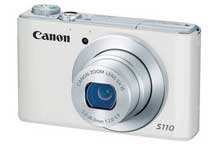
|
Samsung Galaxy Camera 16MP
$399 Why: Basically an camera with Android operating system. Samsung's carpet
bombing approach to marketing. Throw things out and see what sticks. Equivalent
23-483mm f2.8-5.9 1/2.3" sensor. 283g. Huge zoom range. 23mm is very
wide.483mm is very high zoom. Large Android screen makes show and tell sharing
easy. Makes great sense for casual photographers who wants a step up from
smart phones.

|
Casio EX-100 12MP $692
Why: Mainly for very high speed video. Fast lens, large zoom range. Specialty
camera with interesting features. 1000 fps video at 224x64 resolution only.
High speed and circular buffer. Buffer never fills up, just deletes earlier
image. Small 1/1.7" sensor, but is back illuminated, 28-300mm f2.8
lens. up to 30FPS speed. Incredibly fast 1/20,000 shutter. Slow autofocus.
Not available in US and too expensive. Very similar to Olympus Stylus 1.
High speed video: 512x384@240fps, 224x160@480, 224x64@1000fps.
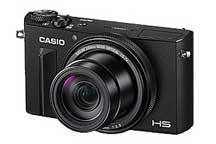
|
Olympus Stylus 1 12MP $699
Why: Fast lens with huge zoom range in a relatively small camera. 28-300mm
f2.8 1/1.7" BSI sensor. 402g. No as fast video like on Casio. Still
does 120fps as 640x480 and 240fps at 320x240. Not too bad. Fast lens and
good zoom. Only issues is 28mm no where near wide enough. Nees to be 24mm
wide. That little bit makes a difference.
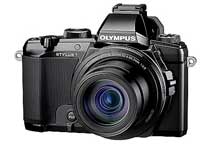 |
Fujifilm X20: $499 12MP
Came out in 2013 Why does it exist: Range finder camera with zoom lens.
Optical viewfinder zooms with the lens. Good: 28-122mm f2-f2.8 fast lens.
Bad: Only 2/3" sized sensor. Is half the diagonal size of the 1"
sensor. This is a point and shoot camera sized sensor. Magnesium top and
bottom plate. Pop-up flash. Hybrid auto focus with focus detector on sensor,
but focus is still not very fast. Somewhat obsolete with larger sensor compact
cameras on the market with equally fast lens. Somewhat unique in that it
has a optical viewfinder.
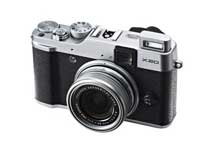 |
Olympus XZ-2 10MP 1/1.7"
sensor. $599 Why: Second brightest lens, just behind Panasonic LX7 below.
Equivalent 28-112mm f1.8-2.5. 346g
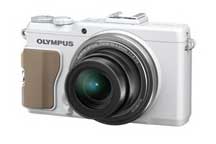 |
Panasonic Lumix DMC-LX7
$397 1/1.7" sensor, Why: Claim to fame as the fastest lens f1.4-2.3
on compact camera category. Just beat out Olympus Stylus X2-2 by .2, from
f2.5 to f2.3 here. 24-90mm f1.4-2.3 10.1MP Responsive autofocus. Very competitive
camera. Best in terms of fast lens that is wide enough, good autofocus.
But not a high zoom camera but adequate. 298g Compare this with the Panasonic
LX100. LX100 is twice as expensive, but has much larger M4/3 sensor, and
equally fast lens. Panasonic makes some very competitive products to make
up for it's non-camera brand.
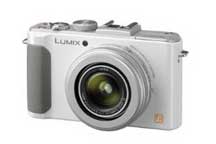 |
Canon G16 12MP $499 1/1.7"
Sensor. Equiv 28-140mm f1.8-2.8. The standard in enthusiast compact camera
for many years. It always had a small sensor, but that was not a problem
for many years. However, other cameras have gone to larger sensor size already,
leaving this behind. Is now more of a downgraded camera. 28mm not wide enough,
but 140mm is pretty long. f1.8 to 2.8 is good, but Panasonic LX7 has faster
lens. Trading longer zoom, but not wide enough on the wide side with faster
lens. WiFi, 12.2/9.2 FPS. 320x240 at 240fps 640x480 120fps. 356g 109x76x40mm
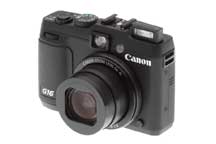 |
Fujifilm X30: $599 12MP
2/3" sensor. equiv 28-112mm f2-2.8 Intro on 9/2014. Why does it exist.
"Improvement" on X20. Difference: No more optical viewfinder.
Electronic viewfinder. Focus peaking. Phase detect autofocus cells on sensor.
Faster autofocus. Better battery life. Same size sensor, same MP, same f2-2.8
aperture. 28-112mm instead of 28-122mm. Control wheel around the lens. 2.3M-dot
EVF has delay of only .005sec. Has a great EVF. Still compare with the strong
competition, this has smaller sensor. 423g 119x72x60mm
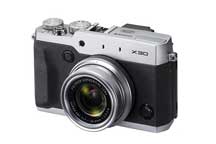 |
Fujifilm XQ1 12MP 2/3"
sensor. $399 Why: Very compact pocket camera with fast lens at the wide
end. Not much else. 25-100mm f1.8-4.9. Optically stabilized. Has EXR mode
like X10. Very small camera, but trade off is slower lens at the high zoom
level. 206g 100x59x33mm
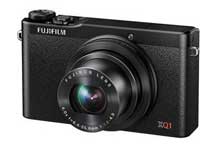 |
Nikon Coolpix P7800 12MP
1/1.7" sensor. $546 Why: Super zoom compact camera. Moderately fast
28-200mm f2-4 lens. Vibration reduction. Has high zoom with vibration reduction,
but now wide enough at the wide end. 24mm is preferable. Flip LCD screen.
399g. 119x78x50mm Controls are slow, and write times are slow.
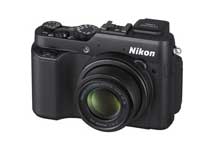 |
Nikon Coolpix P340 12.2MP
1/1.7" sensor. Equiv 24-120mm f1.8-5.6 lens. WiFi Slow write times.
194g 103x58x32
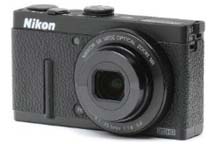
|
Panasonic Lumix DMC-LF1
12.2MP 1/1.7" sensor Equiv 28-200mm f2-5.9 Has viewfinder, but is
slow response. 192g 103x62x28mm
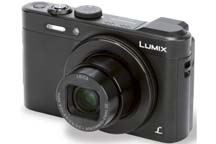
|
Nikon P900 16MP 1/2.3"
sensor. $600 Equiv 24-2000mm f2.8-6.5. Why: This is not just super zoom,
but ultra 83x
zoom. Highest zoom of any camera. Very sharp lens. See moons of Jupiter!
Why not: This is no small camera. DSLR sized, but with small sensor. Excellent
5 stops image stabilization. Articulating LCD, electronic viewfinder,
WiFi, GPS.899g
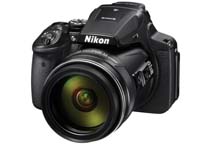
|
Nikon Coolpix P1000 16MP
1/2.3" sensor. $996 Equiv 24-3000mm f2.8-8. If the P900 is not enough
for you, this P1000 has even more zoom at 3000mm. Is also a very slow
lens at f8 at the zoom end. Fun to zoom in on subjects.
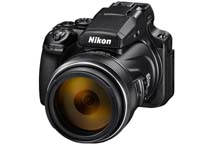
|
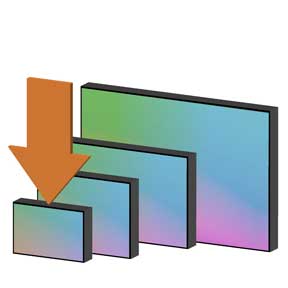
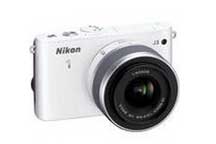

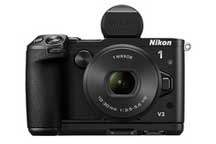
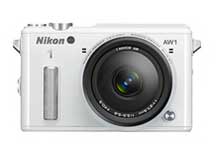
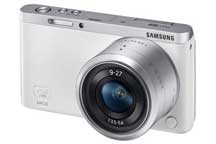





















































 D610
shown, D600 similar.
D610
shown, D600 similar. 

































